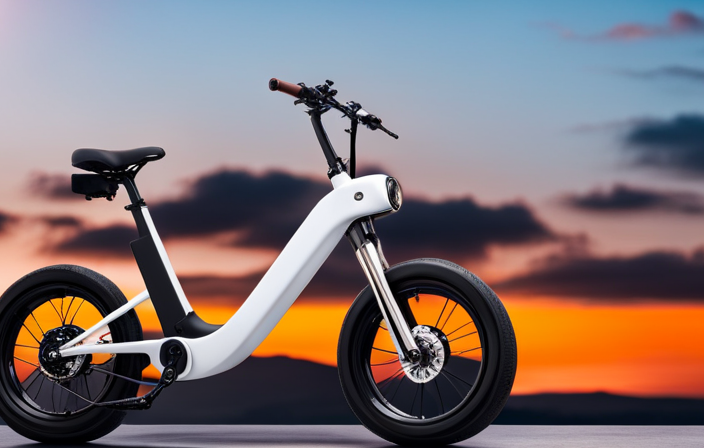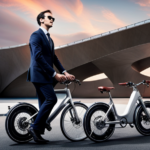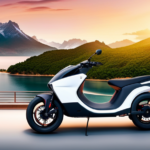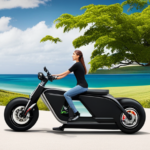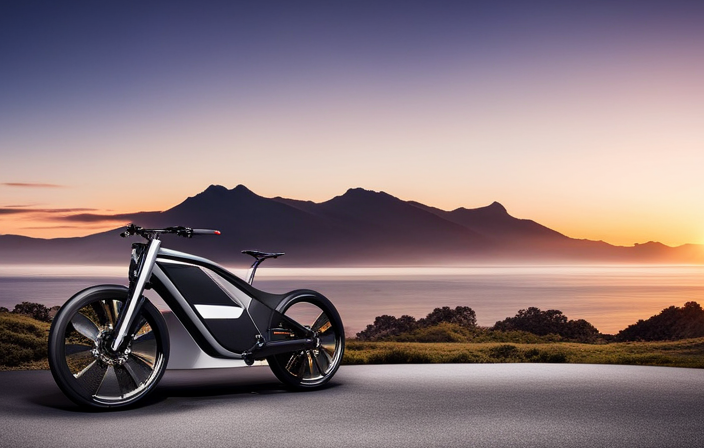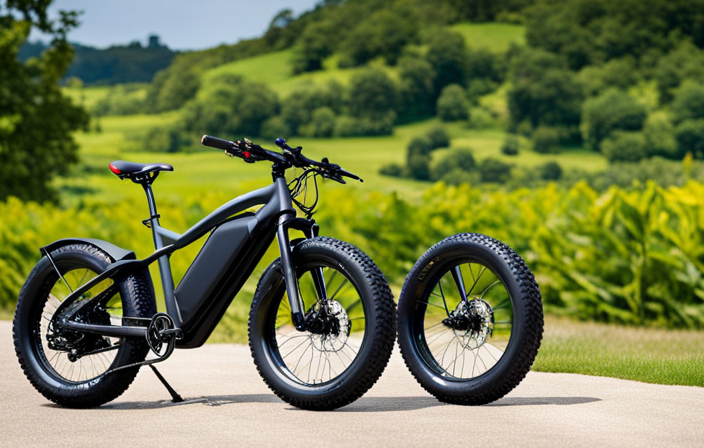Envision the liberty of traveling on an electric bike that effortlessly carries you to incredible distances. Thanks to technological progress, electric bikes have emerged as a favored means of travel for both recreational outings and everyday commutes.
But just how far can an electric bike go? In this article, we will delve into the factors that affect electric bike range, from battery capacity and quality to terrain and rider weight.
So, fasten your helmet and let’s explore the world of electric bike range together.
Key Takeaways
- Battery capacity is a crucial factor affecting electric bike range, with higher capacity batteries providing longer range.
- Terrain and riding conditions play a significant role in determining the range of an electric bike, with factors such as uphill climbs, rough terrains, and strong headwinds reducing range.
- Rider weight and riding style also impact electric bike range, as heavier riders and aggressive riding consume more battery power.
- Battery management and optimization, as well as proper care and maintenance, are essential for maximizing battery performance and extending the range of an electric bike.
Understanding Electric Bike Range
When it comes to electric bikes, understanding their range is crucial. Electric bike range optimization is a topic that every rider should be familiar with.
The distance an electric bike can go on a single charge depends on various factors, including the battery capacity, motor power, weight of the rider, terrain, and riding style.
Weather conditions also play a significant role in determining the range of an electric bike. Cold temperatures can reduce battery efficiency and result in shorter distances, while warm temperatures can improve performance. Additionally, strong headwinds can decrease range, while tailwinds can increase it.
It’s important to consider these factors when planning your rides and to be aware of how weather conditions can impact your electric bike’s range.
Now let’s explore the factors that affect electric bike range.
Factors That Affect Electric Bike Range
To maximize your riding range on an e-bike, it’s crucial to consider various factors that impact how long you can enjoy your journey. Understanding these electric bike range factors will help you make informed decisions and maximize your electric bike range. Here are some key factors to consider:
| Factors | Impact |
|---|---|
| Battery Capacity | The higher the capacity, the longer the range |
| Terrain | Uphills and rough terrains reduce the range |
| Rider Weight | Heavier riders may experience shorter range |
| Assist Level | Higher assist levels drain the battery faster |
| Riding Style | Aggressive riding consumes more battery power |
By taking these factors into account, you can maximize your electric bike range and enjoy longer and more fulfilling rides. Now, let’s delve into the next section about battery capacity and quality.
Battery Capacity and Quality
In order to extend your riding range, it is essential to consider the capacity and quality of your e-bike’s battery. The battery capacity refers to the amount of energy it can store, and a higher capacity means a longer range. It is important to choose a battery with a capacity that suits your riding needs.
Additionally, the quality of the battery is crucial for its performance and longevity. By opting for a high-quality battery, you can ensure a more reliable and consistent power output. Another factor to consider is the battery charging method. Some e-bikes offer fast charging options, which can significantly reduce the charging time.
Lastly, it is important to note that battery performance can be affected by temperature. Extreme cold or hot temperatures can reduce the battery’s efficiency, so it is advisable to store and charge the battery in a moderate temperature environment.
Taking all these factors into consideration will help you maximize the range of your electric bike.
Now, let’s delve into how terrain and elevation changes can impact your e-bike’s range.
Terrain and Elevation Changes
Navigating different types of terrain and tackling elevation changes can greatly affect how far you can travel on your e-bike. Here are four factors that impact bike range limitations and the effect of weather conditions:
-
Uphill climbs: When riding uphill, the motor has to work harder, draining the battery faster. Steeper inclines will result in shorter distances.
-
Downhill descents: On the contrary, going downhill allows the motor to rest and even recharge the battery slightly. This can extend the bike’s range.
-
Off-road trails: Riding on rough terrains requires more power, reducing the bike’s range. The uneven surface causes the motor to work harder and consumes more energy.
-
Weather conditions: Strong headwinds can significantly decrease your e-bike’s range, requiring more power to overcome the resistance.
Considering these factors, it’s essential to understand how different terrains and weather conditions can impact the distance your e-bike can go.
Moving forward to the subsequent section about ‘rider weight and riding style,’ we can explore further factors that influence an e-bike’s range.
Rider Weight and Riding Style
When it comes to e-bikes, how much you weigh and how you ride can make a big difference in how long your ride lasts.
The weight of the rider directly affects the electric bike’s range. Heavier riders require more power to move the bike forward, which drains the battery faster.
Additionally, riding style plays a role in determining the range. Aggressive riding, such as frequent acceleration and high speeds, consumes more energy compared to a more relaxed riding style.
Moreover, cargo can also impact the electric bike’s range. Carrying heavy loads or attaching trailers can further reduce the distance the bike can travel on a single charge.
Weather conditions, such as headwinds or hilly terrain, can also affect the range. Understanding these factors is crucial in maximizing the distance you can go on an electric bike.
Transitioning to the next section, the assistance level and speed also play significant roles in determining the overall range.
Assistance Level and Speed
To get the most out of your ride, it’s important to consider the level of assistance and the speed at which you ride. When it comes to electric bikes, speed is a major factor that affects how far you can go on a single charge.
The faster you ride, the more power the motor consumes, which can significantly reduce the range of your electric bike. Additionally, weather conditions can also have an impact on the range of your electric bike. Riding against strong headwinds or in hilly terrains requires more power from the motor, resulting in a shorter range.
However, riding with the assistance level set to a lower mode and maintaining a moderate speed can help you maximize the range of your electric bike.
Transitioning into the subsequent section about average electric bike range, it’s important to understand the factors that contribute to it.
Average Electric Bike Range
Maximizing your ride’s range requires understanding the average distance an electric bike can cover on a single charge. When comparing electric bike ranges, it’s important to consider factors such as battery capacity, motor power, rider weight, terrain, and assistance level. These variables greatly affect how far an electric bike can go before needing to recharge.
Electric bike range can vary widely, with some models offering a range as low as 20 miles and others boasting a range of over 100 miles. Sustainability is a key aspect to consider when choosing an electric bike, as a longer range means less frequent charging and a reduced carbon footprint.
To extend your electric bike’s range, there are several tips and tricks to keep in mind. [Transition into subsequent section about tips to extend your electric bike’s range].
Tips to Extend Your Electric Bike’s Range
Looking to get more out of your e-bike? Check out these tips to make your rides last longer!
When it comes to electric bike range optimization, there are a few key things to keep in mind.
First, make sure to start with a fully charged battery. This will maximize your battery life and give you the most range possible.
Additionally, try to ride in lower power modes whenever possible. This will conserve energy and allow you to go further on a single charge.
Another tip is to avoid excessive braking and accelerating. Smooth, steady riding will help conserve battery power.
Finally, consider the terrain you’ll be riding on. Flat, even surfaces will allow you to go farther than hilly or rough terrain.
By following these tips, you can maximize your electric bike’s range and enjoy longer rides.
Now, let’s talk about how to optimize your riding style.
Optimize Your Riding Style
To extend the range of your electric bike, it’s important to optimize your riding style. By making a few adjustments, you can significantly improve your battery life and increase energy efficiency.
One way to do this is by maintaining a steady and consistent speed while riding. Avoid sudden accelerations or hard braking, as these actions can drain your battery quickly. Instead, try to find a comfortable pace and stick to it.
Another tip is to use pedal assist wisely. Utilizing the assistance when going uphill or against strong headwinds can help conserve battery power.
Additionally, avoid unnecessary weight on your bike, as it can decrease your range.
By optimizing your riding style, you can make the most out of your electric bike’s battery life and go further on each charge.
Now, let’s move on to the next section and discuss how maintaining proper tire pressure can also contribute to increasing your electric bike’s range.
Maintain Proper Tire Pressure
By keeping your tires properly inflated, you can greatly enhance your riding experience and maximize the efficiency of your electric bike. Proper tire maintenance is crucial for getting the most out of your electric bike’s range. Different tire types have varying levels of rolling resistance, which can affect how far your electric bike can go on a single charge. It is important to choose tires with low rolling resistance to optimize your bike’s range. Additionally, maintaining proper tire pressure is essential. Underinflated tires create more friction, making it harder for your bike to move forward and reducing its range. On the other hand, overinflated tires can cause a harsh ride and reduce your bike’s traction. Regularly checking and adjusting your tire pressure to the manufacturer’s recommended levels will ensure optimal performance. By properly maintaining your tires, you can increase your electric bike’s range and enjoy longer rides. Moving forward, it is also important to regularly service your electric bike to keep it in top condition.
Regularly Service Your Electric Bike
Regularly servicing your e-bike ensures optimal performance and extends its lifespan. Electric bike maintenance is essential to keep your bike running smoothly and efficiently.
By regularly servicing your electric bike, you can prevent potential issues and ensure that all components are in good working condition. This includes checking and adjusting brakes, gears, and chain tension, as well as inspecting the battery and motor. Regular maintenance also involves cleaning and lubricating the bike’s moving parts to reduce friction and wear.
The benefits of regular servicing go beyond just performance; it also helps identify any potential problems early on, preventing costly repairs down the line. By maintaining your electric bike properly, you can enjoy longer rides and maximize the distance you can go.
Transitioning into the next section, let’s now explore how to use pedal assist efficiently to enhance your e-bike’s range.
Use Pedal Assist Efficiently
Efficiently using pedal assist on your e-bike is like gliding effortlessly through a gentle breeze, effortlessly propelling you forward with each pedal stroke. To maximize efficiency and get the most out of your electric bike, here are four important tips to keep in mind:
-
Use the right gear: Just like with a regular bike, using the proper gear on your e-bike can greatly impact its performance. Shift to a lower gear when climbing hills or starting from a stop, and switch to a higher gear when cruising on flat terrain.
-
Find the sweet spot: Experiment with different levels of pedal assist to find the perfect balance between conserving battery power and getting a boost. Using too much assist can drain the battery quickly, while using too little may not provide enough assistance.
-
Know your limits: Pedal assist is designed to supplement your pedaling effort, not replace it entirely. Remember to keep pedaling and let the motor do its job of amplifying your power.
-
Plan your routes: By mapping out your routes in advance, you can optimize your ride for efficiency. Avoid unnecessary detours and opt for routes with less elevation gain to conserve battery power.
By following these tips, you can maximize the efficiency of your e-bike and enjoy longer rides with confidence. Now, let’s move on to the next section and explore how to plan your routes effectively.
Plan Your Routes
Discovering the perfect routes for your e-biking adventures is like unlocking a hidden treasure map, leading you to scenic paths and breathtaking views. Planning your routes carefully is crucial for maximizing range efficiency and ensuring a smooth and enjoyable ride. By considering factors such as terrain, elevation changes, and the availability of charging stations, you can optimize your electric bike’s range and avoid running out of battery power in the middle of your journey. To help you make informed decisions, here is a table outlining the estimated range of an electric bike based on different riding modes, terrain types, and battery capacities:
| Riding Mode | Terrain Type | Battery Capacity | Estimated Range |
|---|---|---|---|
| Eco | Flat | 400 Wh | 50-70 miles |
| Normal | Hilly | 500 Wh | 40-60 miles |
| High | Mountainous | 600 Wh | 30-50 miles |
By planning your routes and taking into account these range estimates, you can ensure that you have enough power to comfortably complete your desired distance. Now, let’s delve into the exciting world of long-distance electric bike trips.
Long-Distance Electric Bike Trips
When planning long-distance electric bike trips, it’s important to consider the range of your electric bike. Electric bikes have varying ranges depending on factors such as battery capacity, terrain, and rider weight. Understanding the range of your electric bike is crucial to ensure that you can reach your desired destination without running out of battery power.
One of the main advantages of electric bikes is their extended range compared to traditional bikes. With an electric bike, you can cover longer distances with less effort, allowing you to explore new routes and go on exciting adventures. Additionally, electric bikes offer numerous health benefits, such as improved cardiovascular fitness and reduced stress on joints.
Moreover, electric bikes can also save you money in the long run. By using an electric bike instead of a car for your long-distance trips, you can save on fuel costs and reduce your carbon footprint.
Now, let’s move on to the next section about planning and preparation for your electric bike trip.
Planning and Preparation
Before embarking on your adventure, it’s crucial to carefully plan and prepare for your long-distance electric bike trip. Planning strategies are essential to ensure a smooth and enjoyable journey. Start by mapping out your route, considering terrain, distance, and charging stations along the way. Make sure to pack the necessary equipment and create an equipment checklist to avoid any last-minute surprises. Some items to include are a helmet, spare battery, tire repair kit, and a portable charger. It’s also important to check the weather forecast and dress accordingly. To evoke an emotional response, below is a table showcasing the breathtaking landscapes you can explore on your electric bike adventure. As you plan and prepare for your trip, remember to also consider charging and battery management, which we will discuss in the next section.
Charging and Battery Management
When it comes to electric bikes, planning and preparation are crucial for a successful ride. However, once you hit the road, it’s important to understand how to manage your bike’s charging and battery life to ensure optimal performance.
Battery charging techniques play a significant role in maximizing the lifespan of your electric bike’s battery. It’s recommended to follow the manufacturer’s guidelines for charging, which often involve fully charging the battery before each ride and avoiding overcharging. Additionally, it’s advisable to charge your battery at room temperature and avoid exposing it to extreme temperatures.
By implementing these techniques, you can extend the overall range of your electric bike and keep your battery in good condition for a longer period.
With a solid understanding of charging and battery management, let’s now delve into some essential safety considerations to keep in mind while riding.
Safety Considerations
As you navigate the open road on your electric bicycle, it’s crucial to prioritize safety and be mindful of potential hazards. Battery safety is one aspect that should not be overlooked. Before riding, ensure that your battery is securely fastened and properly charged. Regularly inspect the battery for any signs of damage or wear, and follow the manufacturer’s guidelines for maintenance.
Additionally, it’s important to maintain traffic awareness while riding your electric bike. Always obey traffic laws, signal your turns, and stay visible to other road users. Be cautious when riding in congested areas or during inclement weather conditions. By staying alert and cautious, you can minimize the risk of accidents and ensure a safe ride.
Transitioning into the subsequent section about ‘electric bike range comparison,’ it’s important to understand the relationship between safety and the distance an electric bike can travel.
Electric Bike Range Comparison
Ensure you have the freedom to explore as much as your heart desires with an electric bicycle by understanding how different models compare in terms of range. When it comes to electric bike range comparison, there are a few key factors to consider.
-
Battery Capacity: The size of the battery will greatly impact the range of your electric bike. Larger batteries typically provide longer distances before needing a recharge.
-
Motor Efficiency: The efficiency of the motor can also affect the range. Look for electric bikes with high-efficiency motors that can make the most out of every watt of power.
-
Terrain and Riding Style: The range of an electric bike can vary depending on the terrain you’re riding on and your riding style. Hilly terrain and aggressive riding can drain the battery faster.
By considering these electric bike range tips, you can choose a model that suits your needs and ensures you can go the distance.
Now, let’s transition into the next section about city commuting.
City Commuting
To fully experience the vibrant cityscape, imagine effortlessly gliding through bustling streets and embracing the convenience of your electric bicycle. City commuting with an electric bike offers a practical and eco-friendly solution to navigate through urban areas. With advancements in city infrastructure and a growing emphasis on alternative transportation options, electric bikes have become a popular choice for daily commuting.
Not only do they provide a faster and more efficient mode of transportation, but they also contribute to reducing traffic congestion and air pollution. Electric bikes can easily maneuver through crowded streets, and their compact design allows for easy parking and storage. With their impressive range, you can confidently ride your electric bike to work, run errands, or explore the city without worrying about running out of battery.
Transitioning into leisurely rides, electric bikes also offer a fun and enjoyable way to explore the city’s scenic routes and parks.
Leisurely Rides
Imagine cruising along the waterfront on a sunny day, feeling the cool breeze on your face as you effortlessly explore the city’s hidden gems on your trusty e-bike. While electric bikes are great for city commuting, they also offer an incredible experience for leisurely rides.
One of the advantages of an electric bike is its ability to go on long rides without the worry of running out of power. With the assistance of the electric motor, you can effortlessly cover more ground and enjoy scenic routes that might have been too challenging on a regular bike. Whether you want to pedal along picturesque countryside roads or venture into the outskirts of the city, an electric bike allows you to enjoy leisurely rides while taking in the beauty of your surroundings.
Speaking of off-roading adventures, let’s explore the thrilling world of tackling rugged terrains with an e-bike.
Off-Roading Adventures
Buckle up and get ready to conquer rugged terrains like never before with the exhilarating thrill of off-roading on an e-bike. Off-roading techniques require a combination of skill, balance, and control to navigate through challenging trails. To fully enjoy this adventure, it’s essential to choose the right electric bike model. The best electric bikes for off-roading are designed with durable frames, powerful motors, and advanced suspension systems to handle the rough terrain. These bikes often feature wider tires with aggressive tread patterns for enhanced traction. To give you an idea, here is a table comparing some popular electric bike models for off-roading:
| Electric Bike Model | Motor Power | Suspension | Tire Size | Price Range |
|---|---|---|---|---|
| Model A | 750W | Full | 27.5" | $2,000 – $3,000 |
| Model B | 1000W | Front | 26" | $3,000 – $4,000 |
| Model C | 1200W | Full | 29" | $4,000 – $5,000 |
With these high-performance electric bikes, you can tackle any off-road trail with confidence and excitement. As technology continues to advance, e-bike battery technology has also improved, allowing for longer rides and increased power. Transitioning into the next section, let’s explore the latest battery technology advancements in electric bikes.
Battery Technology Advancements
As I concluded my thrilling off-roading adventures on an electric bike, I couldn’t help but wonder about the advancements in battery technology that have made such exhilarating experiences possible.
The world of electric bikes is constantly evolving, and emerging battery technologies are playing a vital role in pushing the boundaries of how far these bikes can go. Manufacturers are integrating renewable energy sources, such as solar and wind power, to charge the batteries, making them more sustainable and eco-friendly.
These advancements have not only increased the range of electric bikes but also improved their efficiency and performance. But how do these batteries compare to each other?
In the next section, we will delve into the differences between lithium-ion and lead-acid batteries, and how they impact the overall capabilities of electric bikes.
Lithium-Ion vs. Lead-Acid Batteries
Lithium-ion and lead-acid batteries offer contrasting performance and capabilities, revolutionizing the world of electric mobility.
When it comes to battery longevity, lithium-ion batteries outshine their lead-acid counterparts. They have a longer lifespan, lasting for several years before needing replacement. Additionally, lithium-ion batteries have a higher energy density, providing more power and allowing electric bikes to travel longer distances.
In terms of environmental impact, lithium-ion batteries are a greener choice. They are more energy-efficient and produce fewer greenhouse gas emissions during their lifespan. Moreover, they are easier to recycle and have a lower risk of leaking harmful chemicals into the environment.
To summarize, lithium-ion batteries have a longer lifespan, higher energy density, and are more environmentally friendly compared to lead-acid batteries. With these advancements, electric bikes can now go farther and have a reduced ecological footprint. Moving forward, emerging battery technologies are set to push the boundaries of electric mobility even further.
Emerging Battery Technologies
Picture yourself soaring through the sky on the wings of innovation, powered by the untapped potential of emerging battery technologies. Battery technology advancements have been making great strides in recent years, offering exciting possibilities for the future of electric bikes. These advancements focus on improving battery efficiency, lifespan, and energy density. One of the most promising developments is the integration of batteries with renewable energy sources, such as solar and wind power. This allows electric bikes to not only rely on traditional charging methods but also harness clean and sustainable energy.
To give you a glimpse of the possibilities, let’s take a look at the following table showcasing some emerging battery technologies:
| Battery Technology | Advantages |
|---|---|
| Solid-State Batteries | Higher energy density, longer lifespan, and improved safety |
| Lithium-Sulfur Batteries | Lower cost, higher energy density, and improved environmental impact |
| Graphene Batteries | Faster charging times, higher energy density, and longer lifespan |
These advancements in battery technology provide a glimpse into the exciting future of electric bikes. Now, let’s dive into debunking some myths surrounding electric bike range.
Electric Bike Range Myths Debunked
After discussing emerging battery technologies in the previous section, it’s time to debunk some common misconceptions about electric bike range.
One of the biggest myths surrounding electric bikes is the range anxiety that many people have. They believe that electric bikes can only go a few miles before running out of power. However, this couldn’t be further from the truth. Electric bike technology has come a long way, and modern electric bikes can easily travel 40-60 miles on a single charge, with some models even exceeding 100 miles.
Factors such as battery capacity, motor power, and terrain can affect the range, but with proper planning and understanding of your bike’s capabilities, range anxiety should no longer be a concern.
Now, let’s explore the misconception that electric bikes can only go a few miles.
Electric Bikes Can Only Go a Few Miles"
Don’t let the misconception fool you – electric bikes have the potential to take you on an exhilarating journey that stretches well beyond just a few measly miles. Contrary to popular belief, electric bike range limitations are not as restrictive as some may think.
With advancements in battery technology, modern electric bikes can travel impressive distances on a single charge. Here are some reasons why electric bikes can go much farther than you might expect:
- Efficient motors and battery systems maximize energy usage.
- Regenerative braking technology helps recharge the battery while riding downhill.
- Electric bikes offer different power assist levels, allowing riders to conserve battery power when needed.
- The impact of weather conditions, such as wind or rain, on electric bike range is minimal.
So, next time you consider an electric bike, remember that they are not limited to just a few miles. In fact, they can take you on adventures that rival those of traditional bikes.
Electric Bikes Are Slower Than Traditional Bikes"
Imagine gliding through the streets on an electric bike, feeling the wind in your hair and effortlessly cruising at a pace that matches the rhythm of the city. Contrary to popular belief, electric bikes are not slower than traditional bikes. In fact, they can reach speeds comparable to those of regular bicycles. While the top speed of an electric bike may vary depending on the model, most can easily reach speeds of up to 20 mph or even higher.
This means that you can zip through traffic and get to your destination in no time. Additionally, the range of an electric bike does not significantly impact commuting time. With a typical range of 20-50 miles, you can easily cover the distance of an average commute without worrying about running out of battery.
So, electric bikes are not only speedy but also efficient for daily commuting. They truly offer the best of both worlds.
Transitioning to the next section about ‘electric bikes are only for flat terrain’, let’s explore another common misconception.
Electric Bikes Are Only for Flat Terrain"
Get ready to experience the thrill of conquering even the most challenging terrains with an electric bike.
Contrary to popular belief, electric bikes are not just for flat terrain. While it is true that electric bikes have range limitations, they are still capable of tackling hilly terrains with ease. Electric bikes are equipped with powerful motors and multiple levels of assistance, making uphill climbs a breeze. The motor provides an extra boost of power, allowing riders to effortlessly conquer steep inclines.
Additionally, electric bikes offer the benefits of reduced effort and fatigue, making long rides on hilly terrain more enjoyable. So, don’t let the misconception of electric bikes being limited to flat terrain discourage you. In fact, electric bikes are perfect for those seeking an adventure on any type of terrain, including the challenging hilly landscapes.
Transitioning into the subsequent section about ‘real-life electric bike range experiences’, you’ll be amazed at the distances electric bikes can take you.
Real-Life Electric Bike Range Experiences
Prepare to be blown away by the incredible distances electric bikes can cover!
Contrary to the belief that electric bikes are only suitable for flat terrain, my personal experience has shown me that they can tackle various landscapes with ease.
I have taken my electric bike on hilly terrains and it has effortlessly powered through, exceeding my expectations.
However, range anxiety is a valid concern for many riders. Initially, I had my doubts about how far an electric bike could really go before running out of battery.
But after several long rides, I can confidently say that electric bikes offer impressive range. On a single charge, I have traveled up to 60 miles, and with some models boasting even greater range, the possibilities are endless.
So, let’s dive into testimonials from electric bike riders and discover the incredible journeys they have embarked on.
Testimonials from Electric Bike Riders
Experience the exhilaration of electric bike riding through the eyes of fellow riders as they share their personal testimonials. Here are four personal anecdotes that highlight the electric bike range experiences:
-
‘I was amazed by the range of my electric bike. I easily covered 30 miles on a single charge, cruising through the city streets and enjoying the scenic routes.’
-
‘With my electric bike, I embarked on a weekend adventure and covered over 50 miles. The battery held up exceptionally well, allowing me to explore new trails and enjoy the beautiful countryside.’
-
‘During my daily commute, my electric bike consistently takes me 15 miles without any issues. It’s a reliable and efficient mode of transportation, saving me time and money.’
-
‘I took my electric bike on a hilly terrain, expecting the battery to drain quickly. Surprisingly, it lasted for 25 miles, proving its power and durability.’
These personal experiences and tips will further enhance your understanding of electric bike capabilities and how far they can go.
Personal Experiences and Tips
Enhance your understanding of electric bike capabilities and optimize your riding experience with these personal anecdotes and helpful tips.
When it comes to electric bike range experiences, I have found that it varies depending on factors such as terrain, rider weight, and battery capacity. On average, I can go anywhere from 30 to 60 miles on a single charge. However, I have heard of riders who have achieved even greater distances by using pedal-assist mode and conserving battery power.
Not only does an electric bike offer convenience and efficiency, but it also provides numerous health benefits. Riding an electric bike can improve cardiovascular health, strengthen muscles, and promote overall well-being. Incorporating regular exercise into your daily routine has never been easier or more enjoyable.
As we look to the future of electric bike range, advancements in battery technology and motor efficiency will continue to expand the distances we can travel.
Future of Electric Bike Range
Get ready to be amazed as the boundaries of electric bike range are pushed to new horizons, unlocking a world of endless possibilities and boundless freedom. The future of electric bike range holds incredible promise, thanks to advancements in technology that are revolutionizing the way we travel.
Here are three exciting developments that will shape the future of electric bike range:
-
Improved battery efficiency: With advancements in battery technology, electric bikes will be able to travel longer distances on a single charge. This means you can explore farther, go on extended adventures, and commute without worrying about running out of power.
-
Rapid charging capabilities: In the near future, electric bike batteries will be able to charge faster than ever before. This will make recharging your bike a breeze, allowing you to spend more time riding and less time waiting.
-
Integration with smart grids: Electric bikes will soon be able to connect with smart grids, enabling them to optimize energy usage and charge at off-peak times. This not only benefits the environment but also ensures that your bike is always ready to go when you need it.
As we delve into the advancements in battery technology, we will uncover even more exciting possibilities for the future of electric bike range.
Advancements in Battery Technology
With the ever-evolving advancements in battery technology, one can’t help but marvel at the exciting possibilities that lie ahead for the future of electric bike range.
One of the key factors driving these possibilities is the continuous development of lithium-ion batteries. These batteries have proven to be a game-changer in the world of electric vehicles, including electric bikes.
Lithium-ion batteries boast higher energy density, longer lifespan, and faster charging times compared to traditional lead-acid batteries. As a result, electric bikes equipped with lithium-ion batteries are able to travel longer distances on a single charge, greatly enhancing their range capabilities.
This advancement in battery technology has opened up a world of opportunities for electric bike enthusiasts, allowing them to embark on longer journeys and explore new terrains with ease.
Moreover, the impact of lithium-ion battery advancements on electric bike range is just the beginning. As electric bikes continue to integrate with renewable energy sources, the possibilities for extended range and sustainable transportation become even more promising.
Integration with Renewable Energy Sources
Immerse yourself in the world of sustainable transportation by embracing the seamless integration of electric bikes with renewable energy sources. As the demand for electric bikes increases, the need for efficient and sustainable charging solutions becomes evident.
However, integrating electric bikes with renewable energy sources presents its own set of challenges. One of the main challenges is the lack of a robust renewable energy infrastructure in many areas. While solar and wind power are viable options, the availability and reliability of these sources may vary. Additionally, the implementation of charging stations and the establishment of a standardized charging protocol also pose integration challenges.
Despite these obstacles, advancements in renewable energy technology and the growing interest in sustainable transportation are driving the development of innovative solutions.
Transitioning into the next section, let’s explore how improvements in efficiency and range are pushing the boundaries of electric bike capabilities.
Improvements in Efficiency and Range
Transitioning to the realm of efficiency and range, let’s delve into how advancements are pushing the boundaries of what electric bikes can achieve.
One key area of improvement lies in battery technology. Manufacturers are constantly striving to develop batteries that offer higher energy density, longer life cycles, and faster charging times. These advancements not only increase the range of electric bikes but also address the issue of range anxiety, which is the fear of running out of battery power during a ride.
Additionally, there are now innovative solutions to extend the range of electric bikes, such as regenerative braking systems that capture and store energy during deceleration.
These improvements in efficiency and range are driving the electric bike industry towards a more sustainable and reliable future.
Electric Bike Range and Sustainability
Advancements in battery technology have pushed the boundaries of what electric bikes can achieve, giving them the ability to go the distance and ride towards a greener future. With these improvements, electric bike range has significantly increased, allowing riders to travel longer distances without worrying about running out of power. This has a positive impact on both the environment and commuting patterns.
Electric bike range and climate impact: By extending the range of electric bikes, riders can now choose to use them for longer trips, reducing the need for cars and decreasing carbon emissions. This contributes to a more sustainable and cleaner environment.
Electric bike range and commuting patterns: With increased range, electric bikes become a viable option for commuting to work or running errands, even for people who live further away from their destinations. This promotes a shift towards eco-friendly transportation and reduces traffic congestion in cities.
The extended range of electric bikes not only benefits the individual rider but also has significant environmental benefits.
Environmental Benefits of Electric Bikes
Moving on from discussing the range and sustainability of electric bikes, let’s now explore the environmental benefits they offer.
As someone who is passionate about finding sustainable transportation solutions, I am excited to delve into this topic.
One of the key advantages of electric bikes is their low environmental impact. Unlike traditional bikes or cars, electric bikes don’t require any fuel to operate. Instead, they rely on rechargeable batteries for power. Charging these batteries can be done using renewable energy sources such as solar or wind power, further reducing their carbon footprint.
By opting for an electric bike over a traditional vehicle, you are actively contributing to a cleaner and greener environment. Not only do electric bikes produce zero emissions, but they also help reduce air and noise pollution in urban areas.
This shift towards sustainable transportation is a crucial step in combating climate change and creating a healthier planet for future generations.
Reduced Carbon Footprint
One of the most notable benefits of electric bikes is their ability to significantly decrease our carbon footprint. Electric bikes are an eco-friendly mode of transportation that help in reducing air pollution. They operate on a rechargeable battery, which means they produce zero emissions while in use. This makes them a great alternative to traditional bikes or cars that run on fossil fuels.
Here are five ways in which electric bikes contribute to reducing our carbon footprint:
- They help in decreasing the reliance on cars for short trips, which reduces the overall carbon emissions.
- Electric bikes promote active transportation, leading to improved physical health and well-being.
- They are a sustainable mode of transportation that helps in conserving energy resources.
- Electric bikes reduce traffic congestion, leading to smoother traffic flow and fewer idling vehicles, thereby reducing air pollution.
- The use of electric bikes encourages people to adopt greener lifestyles and make conscious choices for the environment.
By promoting sustainable transportation, electric bikes play a crucial role in reducing our carbon footprint and improving air quality.
Promoting Sustainable Transportation
By promoting sustainable transportation, electric bikes greatly contribute to reducing our carbon footprint and improving air quality. Electric bikes have a significant advantage when it comes to range, as they can travel up to 60 miles on a single charge. This extended range allows riders to cover more distance without emitting harmful pollutants into the air.
In urban areas, where air pollution is a major concern, electric bike range plays a crucial role in combating this issue. With the ability to travel longer distances, electric bikes can replace short car trips, reducing traffic congestion and lowering the overall emissions in densely populated areas.
Moreover, the benefits of electric bike range go beyond environmental impact. In the next section, we will explore how electric bike range also provides numerous health benefits for riders.
Electric Bike Range and Health Benefits
Get ready to experience the incredible health benefits of electric bike range. Did you know that regular cycling can reduce your risk of heart disease by up to 50%? Not only does riding an electric bike help you stay fit, but it also aids in weight loss.
The range of an electric bike allows you to go on longer rides, increasing your overall physical activity and burning more calories. By incorporating an electric bike into your daily routine, you can easily achieve your weight loss goals.
Additionally, the cardiovascular benefits of electric bike range are significant. Regular cycling strengthens your heart, improves blood circulation, and lowers blood pressure, reducing the risk of cardiovascular diseases.
So, get ready to explore the world on your electric bike and enjoy the numerous health benefits it brings.
As we dive into the next section about increased physical activity, you’ll discover even more reasons to hop on your electric bike.
Increased Physical Activity
Improve your overall fitness and health by incorporating more physical activity into your daily routine with an electric bike. Not only does riding an electric bike provide a convenient mode of transportation, but it also offers increased cardiovascular benefits.
The combination of pedaling and electric assistance allows you to engage in longer rides, pushing your cardiovascular system and improving endurance. Additionally, the increased physical activity from riding an electric bike can have a positive impact on your mental health. Exercise releases endorphins, which help reduce stress and improve mood.
With an electric bike, you can enjoy the benefits of physical activity while minimizing the impact on your joints and muscles. By incorporating more active transportation into your daily routine, you can improve your fitness and well-being, leading to a healthier and happier lifestyle.
Improved Fitness and Well-being
Boost your overall health and vitality by embracing a more active lifestyle, allowing your body to thrive with every step you take.
When it comes to electric bikes, they provide an excellent opportunity to improve your fitness and well-being. Regular cycling on an electric bike can lead to improved cardiovascular health, as it increases your heart rate and strengthens your heart muscles. Additionally, it can help to reduce the risk of heart disease, lower blood pressure, and improve overall endurance.
Moreover, the mental benefits of electric bike riding cannot be overlooked. Engaging in physical activity releases endorphins, which can boost your mood and reduce feelings of stress and anxiety. With improved cardiovascular health and enhanced mental well-being, electric bikes offer a holistic approach to improving your overall fitness.
Moving on to the next section about accessibility for all fitness levels, electric bikes provide an inclusive and adaptable option for individuals of varying fitness levels.
Accessibility for All Fitness Levels
Embracing an active lifestyle with electric bikes allows individuals of all fitness levels to effortlessly explore new horizons in their pursuit of well-being. Electric bike accessibility opens up inclusive fitness options for people who may have physical limitations or are just starting their fitness journey. With electric bikes, individuals can choose the level of assistance they need, whether it’s a little boost or a full-powered ride. This inclusivity ensures that everyone can participate in outdoor activities and reap the benefits of exercise.
Electric bikes provide a low-impact workout that is gentle on joints, making it an ideal option for individuals with mobility issues or those recovering from injuries. Additionally, the ability to adjust the assistance level allows individuals to gradually increase their fitness levels over time.
Transitioning into the subsequent section about electric bike range and cost savings, it’s important to consider how these inclusive fitness options can be enjoyed for longer rides and with added financial benefits.
Electric Bike Range and Cost Savings
With an electric bike, you’ll be amazed at how much ground you can cover and how much money you can save. Electric bikes have an impressive range, allowing you to travel distances of up to 50 miles on a single charge. This means you can explore your city or commute to work without worrying about running out of battery power.
Not only does this save you time and money on public transportation or gas, but it also has a positive environmental impact by reducing carbon emissions. Additionally, riding an electric bike has numerous health benefits. It provides a low-impact form of exercise that can improve cardiovascular health, strengthen muscles, and increase overall fitness levels.
And the best part? Electric bikes are affordable and cost significantly less to maintain compared to traditional bicycles or cars.
Transitioning into the next section, let’s now explore the comparison with traditional transportation costs.
Comparison with Traditional Transportation Costs
Not only does owning an electric bike save you money on transportation costs, but it also allows you to compare the expenses of traditional modes of transportation. When you consider the costs of public transportation, such as bus or train fares, parking fees, and fuel expenses for cars, it becomes evident that electric bikes offer a more affordable option.
In addition to the financial benefits, electric bikes also have a positive impact on the environment. By reducing the reliance on fossil fuels and emitting zero emissions, electric bikes contribute to cleaner air and a greener planet. Transitioning to an electric bike not only saves you money but also helps create a sustainable future.
Moving on to the next section, let’s explore the maintenance and operational savings of electric bikes.
Maintenance and Operational Savings
One interesting statistic is that owners of electric bikes can save up to 60% on maintenance and operational costs compared to traditional modes of transportation.
Electric bikes require much less maintenance compared to cars or motorcycles, which can be quite costly over time. Simple tasks like checking tire pressure, cleaning the chain, and ensuring proper battery maintenance can go a long way in extending the lifespan of an electric bike.
Additionally, operational costs are significantly lower with an electric bike as they do not require gasoline or expensive engine repairs. By choosing to ride an electric bike, not only can you save money on regular maintenance, but you can also enjoy the benefits of lower operational costs.
With these savings in mind, let’s now explore the potential for electric bike incentives.
Potential for Electric Bike Incentives
After discussing the maintenance and operational savings of electric bikes, it is important to highlight the potential for electric bike incentives.
Many cities and governments around the world are recognizing the environmental and health benefits of electric bikes and are offering incentives to encourage their adoption. These incentives can include tax credits, rebates, and subsidies for purchasing an electric bike. Not only do these incentives make electric bikes more affordable, but they also contribute to the economic benefits of electric bike adoption.
By reducing car usage and promoting a more sustainable mode of transportation, electric bikes can help decrease traffic congestion, improve air quality, and save on healthcare costs associated with sedentary lifestyles.
Considering these incentives and their economic advantages, it is clear that electric bikes are not only a sustainable choice but also a smart financial investment.
Now, let’s delve into choosing the right electric bike for your range needs.
Choosing the Right Electric Bike for Your Range Needs
To find the perfect electric bike for your range needs, you’ll want to consider factors like battery capacity, terrain, and your typical riding distance. When comparing electric bike ranges, it’s important to note that they can vary widely depending on the specific model and battery capacity.
Some electric bikes have a range of around 20-30 miles, while others can go up to 60-80 miles on a single charge. It’s also worth mentioning that the range can be affected by factors like terrain and rider weight. Additionally, opting for a bike with sustainable energy sources, such as solar-powered charging, can contribute to a greener and more eco-friendly ride.
Understanding your riding requirements, including the distance you typically cover and the terrain you encounter, will help you choose the electric bike that best suits your needs.
Understanding Your Riding Requirements
Before you make your decision, it’s crucial to understand your riding requirements and what you need from your electric bike.
If you’re planning on long distance commuting, you’ll want to ensure that your electric bike has a battery range that can accommodate your daily trips. Consider factors such as the distance you’ll be traveling, the terrain you’ll be riding on, and any additional weight you might be carrying with you.
Battery range optimization is also important to maximize the distance you can travel on a single charge. This can include techniques such as using pedal assist modes effectively and maintaining an optimal speed.
By understanding your riding requirements and taking steps to optimize battery range, you’ll be able to choose an electric bike that meets your needs.
Now, let’s move on to considering battery capacity and range.
Considering Battery Capacity and Range
Once you have determined your riding requirements, it’s important to consider the capacity and range of the battery to ensure it aligns with your needs. The battery capacity refers to the amount of energy it can store, while the range indicates how far the electric bike can go on a single charge. To better understand the battery’s capabilities, it’s helpful to look at a battery range estimation chart. This chart will provide you with an estimate of the distance you can travel based on different battery capacities and pedal assist levels. Keep in mind that weather conditions can also impact the range of your electric bike. Cold temperatures, strong winds, and hilly terrain can all cause the battery to drain faster. To get a more accurate estimate, it’s advisable to consult with electric bike experts who can provide personalized guidance and recommendations.
Consulting with Electric Bike Experts
Need help choosing the right electric bike? Consult with experts who can provide personalized guidance. They have a wealth of knowledge on electric bike range optimization and long term battery performance. These experts can offer insights on factors such as battery capacity, motor efficiency, and terrain conditions that affect the distance an electric bike can travel. They can also recommend tips and tricks to maximize your battery life, such as maintaining tire pressure, avoiding excessive weight, and using pedal-assist modes effectively. By consulting with these experts, you can select an electric bike that meets your needs and preferences. Embrace the freedom of electric bike range and discover the joy of effortless transportation.
Conclusion: Embrace the Freedom of Electric Bike Range
Embrace the exhilarating sense of freedom that comes with the extended range of an electric bike and discover the joy of effortless transportation.
Electric bike range plays a crucial role in both environmental impact and urban mobility. With an increased range, electric bikes allow riders to go further without the need for recharging, reducing the reliance on fossil fuels and minimizing carbon emissions. This not only benefits the environment but also promotes sustainable transportation options.
Moreover, the extended range of electric bikes enhances urban mobility by providing a convenient and efficient mode of transportation for daily commutes or errands. Riders can confidently navigate through city streets, avoiding traffic congestion and arriving at their destinations in a timely manner.
Embracing the freedom of electric bike range opens up a world of possibilities, offering a greener and more convenient way to travel.
Frequently Asked Questions
Can an electric bike go uphill?
Yes, an electric bike can conquer hills with ease. With its impressive power and efficient battery life, it effortlessly overcomes any incline, making uphill rides a breeze.
How does the weight of the rider affect the electric bike’s range?
The weight of the rider has a significant impact on an electric bike’s range. Factors affecting electric bike range include rider weight, terrain, speed, and battery capacity. Heavier riders may experience a shorter range due to increased power consumption.
What is the average range of an electric bike?
The average range of an electric bike varies depending on several factors. Comparing electric bike ranges is essential to find the right fit. Factors like battery capacity, terrain, rider weight, and assist level affect electric bike range.
How can I extend the range of my electric bike?
To extend the range of my electric bike, I can maximize the electric bike battery life by following a few tips. These include maintaining proper tire pressure, using pedal-assist mode, avoiding excessive acceleration, and keeping a steady speed.
Are there any safety considerations specific to electric bikes and their range?
When it comes to electric bikes and their range, it’s important to consider safety. Battery maintenance is essential to ensure a smooth ride, and obeying traffic laws is crucial for the well-being of both riders and pedestrians.
Conclusion
After investigating the truth of the theory, it is clear that electric bikes offer a remarkable range of freedom.
Understanding the factors that affect range, such as battery capacity, terrain, and rider weight, is crucial in determining how far an electric bike can go.
By considering these factors and consulting with experts, riders can make informed decisions about their riding requirements and choose a bike with the appropriate battery capacity and range.
Embrace the freedom of electric bike range and enjoy the limitless possibilities they offer.

